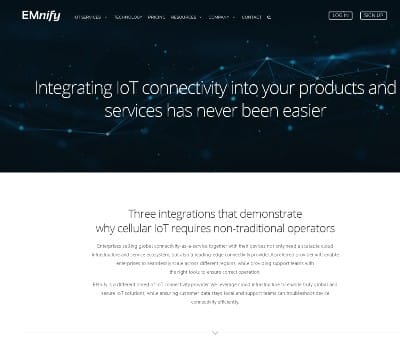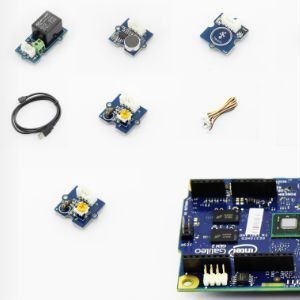
IoT Development Kits
Find and compare the best Internet of Things (IoT) Development Kits. Narrow your board choices and find the best solution for your project and products based on connectivity type, price, etc.
The following Channel Guide will help you:
- Narrow your kit selection based on connectivity type (WiFi, Cellular 3G/GSM, GPS, etc)
- Narrow your kit selection based on target deployment (DIY open source project based on Raspberry pi to full fledged production prototyping with cloud service and APIs enabled)
- Get an overview of kit specs and pricing.
It is predicted that by 2020 we will have between 18 and 50 billion connected devices online. A large chunk of these devices will be using short-range wireless systems such as Bluetooth and Wi-Fi for their connectivity, but according to a GSMA study (PDF) machine-to-machine device connections already account for 2.8% (195 million) of global mobile connections in 2013, and this number is expected to grow as increasingly powerful edge devices drive demand for more robust and global network connections.
As these machines continue to migrate towards more advanced networks, carriers continue to reduce their monthly fee for device links, and some of the kinks (battery life, cost sensitivity, and being overkill for many constrained devices) of cellular connectivity for IoT devices are worked out cellular will take its place as a growing key enabler for IoT devices.
For developers going after those market opportunities, here’s a roundup of development boards and kits that can take your product from concept to prototype to production.
12/01/2020
Featured Firm
EMnify
EMnify is a leading cloud-native IoT connectivity provider that empowers businesses worldwide to get the best out of their devices and overcome industry barriers. EMnify’s connectivity is available in 180 countries with 540 operators globally.
Partner Advertisement
Standalone
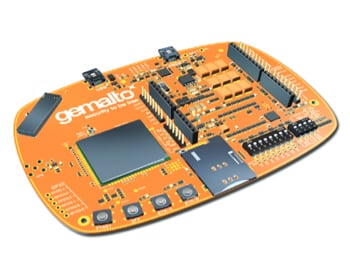
Gemalto Cinterion ConceptBoard
Description:
"Gemalto is moving this concept forward for the embedded space with the Cinterion Concept Board, a user-friendly extendable development kit that leverages Java, Cinterion solutions and the SensorLogic Application Enablement Platform to quickly design and launch next generation M2M solutions."
Pricing:
● €99
Specs:
8 GPIO lines with level-shifters, Compatible with a range of Arduino shields, 5V power supply
PDF Spec Overview
Coverage: 100+ countries, 2G & 3G
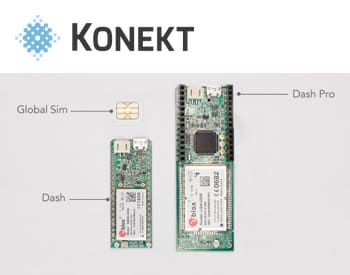
Konekt Line
Description:
Konekt’s Dash and Dash Pro are small cellular development boards that leverage the power of the company’s cloud services. Konekt raised a $1.3 million round of funding in February 2015 to develop IoT data services based on its global SIM card. Hardware production for the Dash boards was financed with a Kickstarter campaign.
Pricing:
● Dash: $59
● Dash Pro: $69
● Complete Solar Kit: $199
● Data Plan: Starts at$1/month, depending on data usage
Specs:
Dash - 12 Analog Inputs (31 GPIO, 1 Dac)Dash Pro - 12 Analog Inputs (18 GPIO, 1 DAC)
- Dimension: Dash Pro: 80 x 30mm -- Dash: 54 x 20.4 mm
Coverage: 100+ countries, 2G & 3G
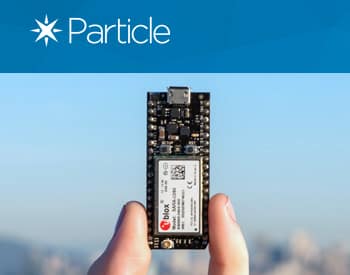
Particle (was Spark) Electron
Description:
Particle’s Electron board is a cellular-connected complement to its Core and Photon Wi-Fi development boards. Electron works with the company’s existing shield modules and draws on the power of the Particle Cloud. The board’s production was funded in April 2015 through a Kickstarter campaign.
Pricing:
● Electron: $39
● Data Plan: $3/month for the first MB, $1 for each additional MB
Coverage: 100+ countries, 2G & 3G
U-Blox SARA U-series (3G) or G-series (2G)
Specs:
- 36 pins total: 28 GPIOs (D0-D13, A0-A13), plus TX/RX, 2 GNDs, VIN, VBAT, WKP, 3V3, RST
- Dimensions: 2.0" x 0.8" x 0.3" (0.5" including headers)
Additional: Postscapes Coverage
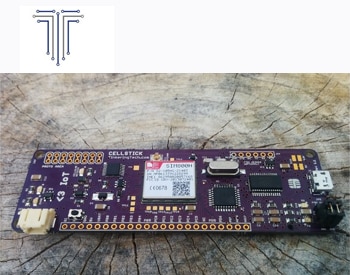
TinkeringTech CellStick
Description:
"Garageio is the simple and secure way to control and monitor your garage door from anywhere in the world, without needing to replace your existing opener.
No more turning around to make sure it is closed. No more leaving it open all night long. Give access to your close friends and family (up to 10 people) and see who is using it and when.."
Price: $59.00
Coverage: - Does not come with a Sim card but supports any 2G/3G SIM card that can register on a 2G cellular network. - SimCom SIM800H cellular module (Quad band850/900/1800/1900MHz)
Specs: On-board LiPo battery charger
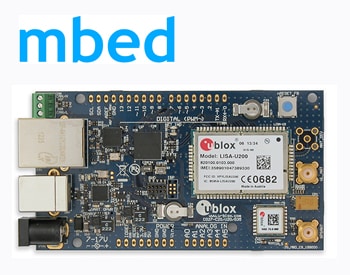
mbed Cellular Kit
Description:
"The C027 is a complete starter kit that allows quick prototyping of a variety of applications for the"Internet of Things" (IoT). The application board has a MAX-7Q GPS/GNSS receiver and a LISA UMTS/CDMA or SARA GSM cellular module, enabling straightforward development of location- aware, global communicating applications. The application board provides access to Ethernet and CAN interfaces and to a variety of HW interfaces (22 GPIOs with SPI, I2C, UART, I2S) through a standard-based header connector."
Price: $199
Additional: Mbed site, Product Summary (PDF)
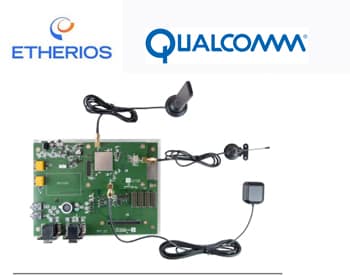
Internet of Everything Development Platform
Description:
"The Internet of Everything (IoE) Development Platform with support for Oracle Java ME Embedded 8 lets software developers and systems integrators innovate, test and deploy IoE applications with embedded cellular connectivity."
Price: $499
Specs:
- Tri-band UMTS/HSDPA 2100/1900/850 MHz
- Quad-band GSM 850/900/1800/1900 MHz
- Standalone GPS, 2.4GHz WiFi b/g/n
Sensors: Accelerometer, Light, Temperature
Cloud: Integration of Device Cloud by Etherios
Additional: Datasheet (PDF)
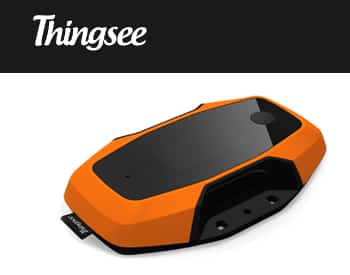
Thingsee One
Description:
"The Internet of Everything (IoE) Development Platform with support for Oracle Java ME Embedded 8 lets software developers and systems integrators innovate, test and deploy IoE applications with embedded cellular connectivity."
Price: $323
Specs:
- 2.5G GSM/GPRS Modem, GSM 850/900/1800/1900 MHz, GPRS Class 10, CS1-CS4 - up to 85.6kb/s,WLAN IEEE 802.11 b/g, Bluetooth LE 4.1
Sensors: location & speed, acceleration, impac, torientation, light, temperature & humidity, air pressure
Battery: Rechargeable Li-Ion Battery 1900mAh
Additional: Datasheet (PDF)
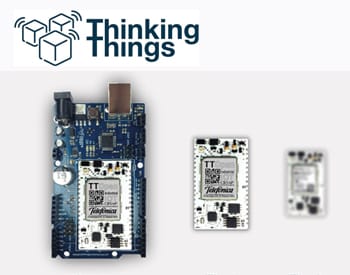
Thinking Things Open Development Board
Description:
"The Thinking Things Open Development Board are used for fast prototyping, functional testing, code development, firmware automatic testing, etc…These boards integrate right away the Thinking Things Open module with the IDE. Code and designs running with the board can be moved straight to the factory."
Specs:
- 850/900/1800/1900MHz, C-SIM (Embedded SIM), GPRS Class 1-12 (configurable)
- IO: 3 Analog Input Pins (A1,A2,A3) 1 Digital IO 3,7v
- Female headers Arduino UNO compatible
- Battery: LIPO 3,7v
Shields
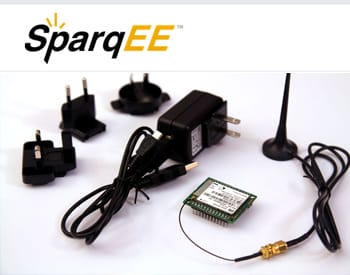
SparqEE Cell
Description:
The SparqEE Cell board adds cellular connectivity to projects based on other development hardware. It can be wired directly into any project, or snapped onto a shield module to connect to Arduino or Raspberry Pi hardware (see below for more examples of cellular shields for those platforms). SparqEE runs free servers for handling data requests.
Pricing:
- SparqEE Cell: $79
- Data Plan: Starts at $3.35/month, depending on data usage
Coverage: 100+ countries, 2G & 3G
- AT&T/T-Mobile in US, 3G and GSM/GPRS Worldwide
- WCDMA/HSDPA 2100/1900/900MHz
- 384Kbps, DL3.6Mbps HSDPA
- GSM/GPRS/EDGE 850/900/1800/1900MHz
Specs: Current Required: Hardware: Raspi and Arduino support --- (If you’re not using a shield, all you need are 4 connections – RX, TX, GND, and Vref for 3.3V or 5V systems...)
Additional: Postscapes Coverage
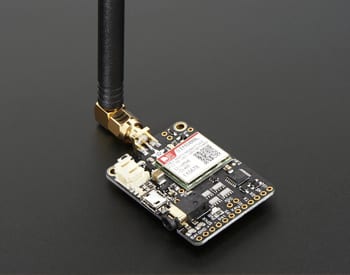
Adafruit Fona
Description:
"Cellular + GPS tracking, all in one? Oh yes! Introducing Adafruit FONA 808 MiniGSM + GPS, an all-in-one cellular phone module with that lets you add location-tracking, voice, text, SMS and data to your project in an adorable little package."
Price: $39.95
Specs: Quad-band 850/900/1800/1900MHz - connect onto any global GSM network with any 2G SIM (in the USA, T-Mobile is suggested)
Power: FONA draws about 20-25mA while running, up to 200mA+ while actually making a call/sending/receiving data, and has very small spikes of up to 2A.
Additional: Docs
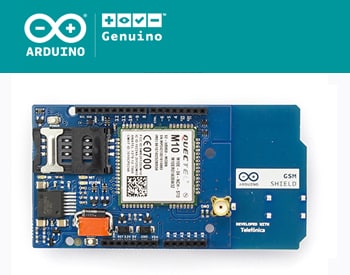
Arduino GSM
Description:
"The Arduino GSM Shield connects your Arduino to the internet using the GPRS wireless network. Just plug this module onto your Arduino board, plug in a SIM card from an operator offering GPRS coverage and follow a few simple instructions to start controlling your world through the internet. You can also make/receive voice calls (you will need an external speaker and microphone circuit) and send/receive SMS messages."
Price: $73
Hardware Support: Uses the 1.0 pinout on rev 3 of the Arduino Uno board
Power requirements: 700mA and 1000mA
Specs:
The M10 is a Quad-band GSM/GPRS modem that works at frequencies GSM850MHz, GSM900MHz, DCS1800MHzand PCS1900MHz.
Coverage: Comes with Telefonica/Movilforum Sim
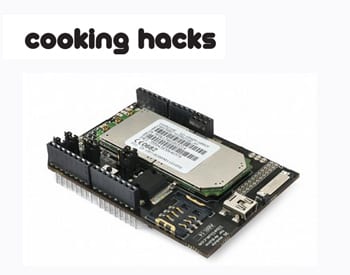
Cooking Hacks: 3G/GPRS shield
Description:
"The 3G shield for Arduino and Raspberry Pi enables the connectivity to high speed WCDMA and HSPA cellular networks in order to make possible the creation of the next level of worldwide interactivity projects inside the new "Internet of Things" era."
Price: $161
Hardware Support: Arduino, Raspberry Pi and Intel Galileo
Specs:
- WCDMA and HSPA 3G networks compatibility
- Internal GPS for Assisted A-GPS and Supported S-GPS modes
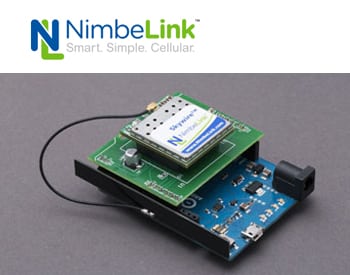
Skywire Arduino Cellular Shield
Description:
"The Skywire™ Arduino Cellular Shield allows easy addition of cellular connectivity to an Arduino implementation for fast, easy prototyping. The Arduino open-source platform provides simple hardware and software for development of interactive projects. It accepts inputs from sensors and can control a variety of actuators. The kit’s Arduino cellular shield works with any of NimbeLink’s pre-certified Skywire™ cellular modems, which are available with bundled, no-contract cellular plans."
Price: $40
Parts List:
Additional: Video
Alternative
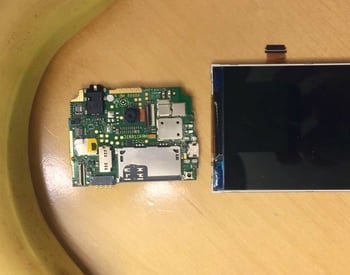
JanOS
Description:
Despite all of the specialized hardware mentioned above, the most obvious way to connect to a cellular network is to use the device that is built for them: the cell phone. Even low-end smartphones contain many of the processors, sensors and radios found in purpose-built IoT hardware, but are mass-produced at significantly lower prices.
JanOS, named for the Norwegian telecom engineer who came up with the idea, is an open-source operating system designed to turn the guts of any discarded smartphone into a cellular-connected IoT development board. So far it only runs on phones compatible with Firefox OS, but the developer community may be able to expand that list quickly by porting the project to work with a wide variety of Android hardware.
Pricing & Coverage: Varies
See also Long range low power systems:
Resources:
- Article: GSMA 1.0 “IoT Device Connection Efficiency Guidelines (PDF)
- GSMA Embedded SIM Specification
- Wireless IoT Forum
Companies: Modules
Companies: Connectivity & MGMT
Related: Prototyping Hardware
Plug and Play Development Kits
Anyone who wants to get started tinkering or creating products for the Internet of Things first has to sift through a bewildering assortment of development and prototyping hardware. The combination of variety and technical complexity can be a significant barrier to entry, especially for amateurs and hobbyists. But a few companies have started designing prototyping kits that don’t require intimate knowledge of GPIO pins or a steady hand with the soldering iron to put your project in motion. Here’s a roundup of development kits that take a user-friendly “plug-and-play” approach—you might call them the literal building blocks of the IoT.
Drag-and-Drop Coding
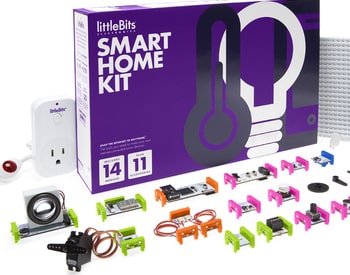
Little Bits
LittleBits was originally an all-purpose electronics kit, but the addition of the CloudBitbrought it into the IoT pantheon. Like the rest of the modules in the series, this thumb drive-sized Wi-Fi adapter snaps magnetically to neighboring components. It adds wireless connectivity and cloud-based programming to any project via IFTTT and LittleBits’ own cloud.
Price: $59 (CloudBit module) / $99 (CloudBit Starter Kit) - Available Now
Connectivity: Wi-Fi
Control: Webapp, IFTTT, API
Modules: 60+
Additional: Postscapes Coverage Funding, Postscapes Cloudbits Coverage, Video
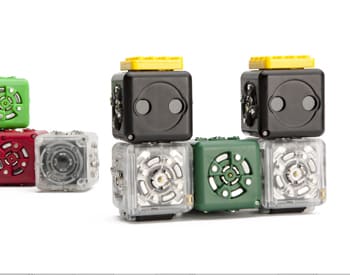
Cubelets
Cubelets are magnetic blocks that can combine to create a wide variety of robots. Each block either acts, senses or thinks—meaning they contain components like motors or speakers, microphones or light sensors, or little bits of logic that can respond in pre-set ways to the data coming from the other blocks. With the addition of a Bluetooth Cubeletto the lineup, it’s possible to reprogram and control the robots wirelessly through several apps for iOS and Android.
Price: $159 (Starter Kit) + $59 (Bluetooth)
Connectivity: Bluetooth
Control: iOS and Android Apps
Modules: 20+
Additional: Moss Robotic Set, Video
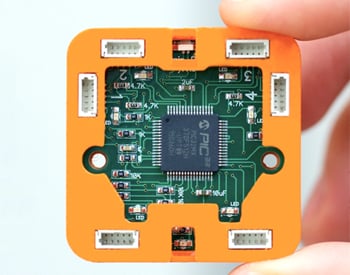
Cubit
Description:
Cubit combines plug-and-play components with drag-and-drop programming. A variety of peripherals plug into the Cubit Controller hub with multicolored wires, and the Cubit Workshop software provides a graphical programming environment where users combine pre-built chunks of code to control the modules in their project. As the creators put it: “If you can make a flowchart, you can create a program” for your electronics project.
Price: $99 (Starter Kit) - Preorder (As of July 2015)
Connectivity: Bluetooth
Modules: 20+
Additional: Postscapes Coverage, Kickstarter Campaign
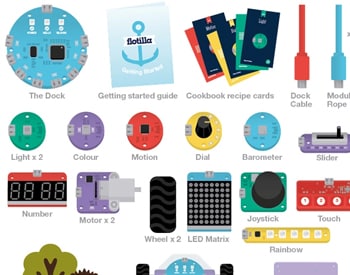
Flotilla
Description:
Pimoroni’s Flotilla kit is an octopus-like extension for the Raspberry Pi, where everything is attached with brightly colored USB-style cables: One from the Pi to the round Flotilla hub, then up to eight more radiating out to connect light sensors, barometers, accelerometers, motors, knobs, buttons, LEDs and other gadgets. Flotilla can be programmed with Rockpool, a drag-and-drop rules engine with a kid-friendly Octopus’s Garden visual motif, as well as other tools.
Price: $36 - $97 (Starter Kits) + ~$35 (Raspberry Pi) (Preorders)
Connectivity: Depends on Raspberry Pi - See Pi connectivity options here.
Modules: 12+
Additional: Postscapes Coverage, Video, Kickstarter Campaign
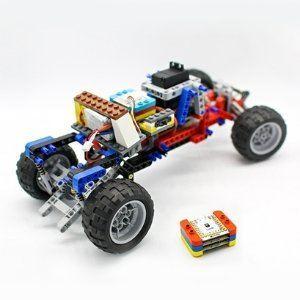
mCookie
Description:
Several of the kits mentioned in this roundup can be adapted for use with Lego blocks, but mCookie (which is basically an upgrade for the Microduino line) was built with Lego in mind from the start. The magnetically stackable components are bordered with brightly-colored plastic featuring the signature bumps that allow them to snap right onto your favorite Lego kits—especially the Technic series, which provides a lot of engineering flexibility for robotics projects. mCookie is fully Arduino-compatible and can be programmed with Scratch, a drag-and-drop graphical coding tool that mirrors mCookie’s “building block” experience.
Price: $78 (Starter Kit)
Connectivity: Wi-Fi, Bluetooth, NFC, Zigbee, GSM/Cellular, GPS, RF
Modules: 20+
Additional: Postscapes Coverage, Video, Microduino
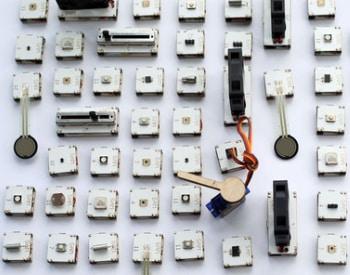
SAM
Description:
SAM modules come in two flavors: sensors, which take in data about the world around them; and actors, which get things done. The lineup is similar to other Internet of Things development kits aimed at less technically inclined users like littlebits, and includes buttons, sliders, and switches; pressure, light, motion, and temperature sensors; and lights, motors, and servos.
Price: $139 (Explore Kit) - $889 (Family Kit)
Connectivity: Bluetooth
Control: Desktop App
Modules: 8+
Additional: Postscapes Coverage, Video
Accesible Programming Environments
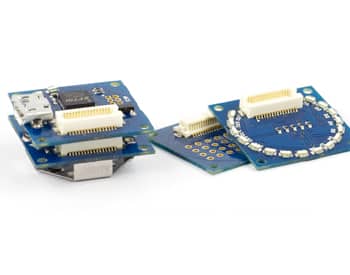
TinyCircuits
Description:
TinyCircuits’ line of miniscule development boards is basically a shrinking-down of the Arduino Uno. Most of the TinyDuinoboards are a mere 20mm square—that’s about three-quarters of an inch, just smaller than a U.S. quarter—and they can be stacked together with chunky plugs to combine multiple components. The company recently Kickstarted a new module called TinyScreen, which features a one-inch OLED display for making teensy gaming consoles, smartwatches and other projects.
Price: $59 (Starter Kit w/o wireless modules) + $59 (Wi-Fi) / $49 (Bluetooth/BLE)
Connectivity: Wi-Fi, Bluetooth, Bluetooth Low Energy
Control: Arduino Environment
Modules: 20+
Additional: Postscapes Coverage
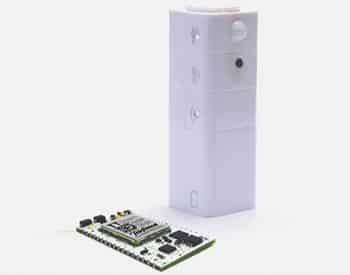
ThinkingThings
Description:
Thinking Things is a modular, mobile sensor platform from Telefonica Lab, part of the R&D wing of Spanish telecom giant Telefonica. The blocky components, which stack together, include a battery, a SIM-equipped connectivity module, and an ambient sensor that tracks temperature, light and humidity. Others, like GPS and motion sensors, are in the works.
Price: $108 (includes 1-year data plan)
Connectivity: GSM/Cellular
Control:Web Interafce, API
Modules: 3+
Additional: Postscapes Coverage

Grove
Description:
"Grove is a modular electronic platform for quick prototyping. Every module has one function, such as touch sensing, creating audio effect and so on. Just plug the modules you need to the base shield, then you are ready to test your idea buds."
Price: $49.90 (Starter Kit)
Connectivity: 315, 433, XBee, Bluetooth
Control: Arduino Sketchbook
Modules: 3+
Additional: Postscapes Coverage
Additional:
- TeagueDuino
"Teagueduino is an open source hardware platform that makes building interactive things a whole lot easier. There's realtime feedback, always-valid code creation, and no soldering required."
Additional Tools:
- NETLab Toolkit
"With a simple drag and drop interface, connect sensors, actuators, media and networks with the smart widgets. Concepts can be prototyped quickly, encouraging iteration, experimentation and testing by sketching in hardware and building connected systems." - Scratch
- Zenodys
- BitReactive
- Wyliodrin
- Ardublock
- Modkit
- miniBloq
- Blockly
- Node-Red
- AT&T Flow Designer
- RaspLogic
- Grasp.IO
- Blynk App
Related: IoT Prototyping Hardware

